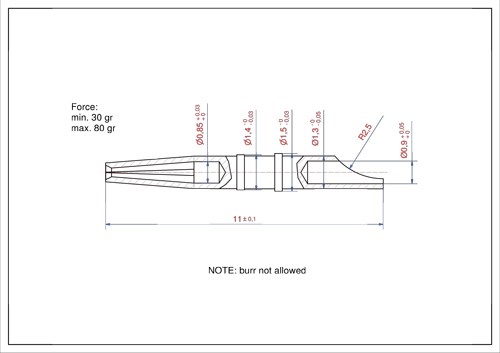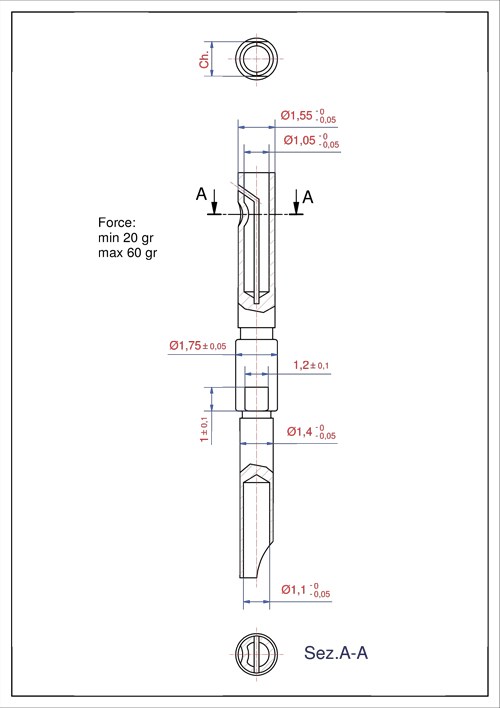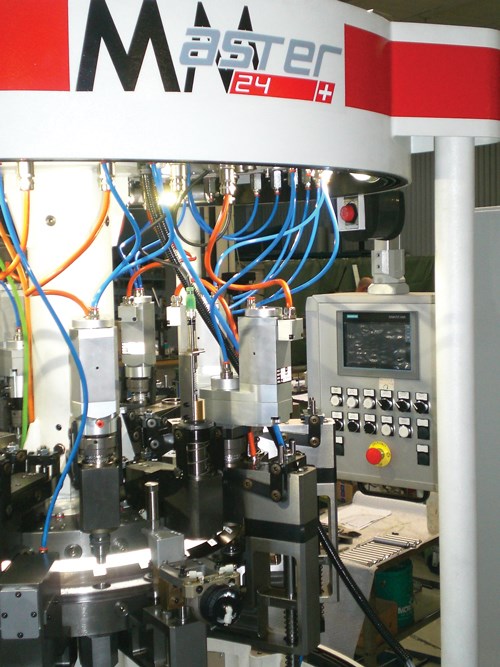Rotary Transfer Versus Swiss for Small Precision Parts
A little creativity goes a long way in meeting the challenges that this high-production application presents.
Micro electrical contacts are the pins of the connectors used in any electronic appliance across all market sectors, such as consumer, automotive, medical, aerospace, home appliance and so on. The contacts are often produced in high volumes, from hundreds of thousands to millions. They may first seem to be simple parts to produce, but actually a lot of technology is involved in these tiny parts.
Normally, when two connectors are plugged together, the female pins in one of the connectors uses some kind of holding system to properly retain the male pins in the other. Such a holding system is critical and must be properly calibrated to ensure proper functioning of the connector.
A Closer Look
Studying a specific example can help demonstrate the challenges in producing these parts. One case study looks at a female contact made of brass or CuBe (copper beryllium)—a contact that is about 3/4 inch (20 mm) long and has a diameter of about 0.05 inch (1.3 mm). Typically, this contact will feature a hole with a half-moon end on one side (necessary to insert the wire and solder it) and a deeper hole on the other side (shaped to hold the male pin when the connector is plugged). A number of solutions can be implemented to give the female contact the necessary holding force (see Figures 1 and 2).
The holding force must be calibrated and controlled accurately, and the machining tolerance is quite tight (0.0012 inch/0.002 inch or 0.03/0.05 mm) as vibration, temperature, or the most severe working conditions must not compromise the proper transmission of the electrical signal throughout the connection. The mid-section ofthe contacts might include grooves and/or flats to properly fit the pin in the connector and possibly to meet other requirements, such as waterproofness. An accurate deburring is always required for these parts to ensure that no burrs remain.
Considering Options
Production volumes for this type of product are generally high. For a family of contacts with different lengths and ODs and different size holes and holding forces, quantities can often reach millions of parts per year. A few different methods offer the capability to produce these contacts in such quantity.
It is certainly possible to produce these contacts with a CNC Swiss multi-spindle machine. These machines work from bar and provide the capability to drill the holes on both sides, as well as all of the other machining requirements. The biggest advantage that these machines provide is flexibility, allowing fast and easy switching from one type of contact to another. Productivity and speed are relatively good with this solution, particularly in cases of small to medium lot sizes with frequent change-over.
Older Swiss mechanical machines with sliding headstock are quite common among the producers of micro electrical contacts. These machines are dependable, accurate and can hold the tight tolerances required. They do have their limitations, though—not all of the necessary machining operations can be made on the same machine. For example, the required holes can be drilled on one side only, so the other holes must be drilled on another machine. These mechanical sliding head Swiss-type machines are often used for this type of work and are perfectly efficient for certain operations, but the machining time and logistical implications must certainly be considered in determining if this is the best option.
Rotary Transfer
The rotary transfer machine is another solution that comes with pros and cons, but with today’s latest technology can provide interesting advantages.
These machines were developed in the late 50s in Switzerland, specifically for high machining precision and high productivity on small, complex parts that were produced in high volume. The idea was to concentrate all machining steps necessary to manufacture such parts on a single multi-station machine based on a rotary indexed table.
So the machine can produce even complex parts complete from raw material. Each station of the rotary table is dedicated to a given machining step, and each individual part goes through the entire machining process without being removed from its holding collet, thus ensuring accuracy and repeatability. At the same time, this machine concept makes it possible to run a large number of parts at the same time, one on each station of the machine, allowing unusually fast cycle times and high production volumes. Today, rotary transfer machines can house as many as 30 or more workstations. Designed for maximum output, each workstation can be individually programmed in terms of stroke start and finish and rpm, and all machining processes run completely under the flow of oil. Standard work units normally range from 4,000 to 24,000 rpm, while a dedicated CNC unit may range up to 60,000 or even 80,000 rpm.
In the case of the electrical contacts, the rotary transfer machine can produce the finished part from raw material, performing all machining and deburring operations, as well as the control and checking operations (calibration and holding force control) necessary to ensure a quality product.
Deburring an internal hole—in particular, the hole that will house the male pin—is necessary to ensure the proper insertion of the pin and the proper transmission of the signal. Generally, this operation is not difficult, as it usually consists of running through the hole a drill tool that is slightly smaller than the hole itself. The idea is to break the burr without touching the walls of the hole. External deburring of a milled cut, on the other hand, can be much more difficult. Deburring the bottom of the cut may require a knife-type tool—an operation that cannot be run in any machine other than a rotary transfer.
The holding force control is a challenging operation because the in-cycle measuring time is short and the machine environment is not ideal. Figure 1 and Figure 2 show the maximum and minimum force allowed for each type of contact. This check requires specific transducers, generally based on piezoelectric (or similar) sensors, and an electronic system capable of processing the signal in the little time available. The advantages of such a check compared with a manual control are the accuracy and repeatability, as well as the capability of checking 100 percent of the parts rather than only running a sample check. Because of the small size of the contact, manual insertion of the checking pin cannot be done consistently with the same angle, and the measurement is not particularly reliable. So if the tolerance of the holding force is tight, in-cycle control is necessary. If, on the other hand, the tolerance of the holding force is not that critical, a manual check may be enough, and the cost of an in-cycle system can be saved.
Back to our case study, the cycle time of the transfer machine is the fastest of all solutions so far presented, and the machine can work from wire (not from bar), which is certainly an advantage. So, in terms of productivity, logistics and cost, the rotary transfer machine is a great solution, if not the best. Flexibility, however, can be a weak point. In fact, these rotary transfer machines are generally mechanical machines, and to switch production from one type of contact to another may not be that easy and fast. If production lots are not sufficiently large, these machines likely are not fast enough. So what is the best solution?
Optimal Solution
“First of all, I would look at the characteristics of the product to machine,” says Manrico Caglioni, director of MiniMecCH USA. “What are the part types and their range of diameters, lengths, and so on? This helps to find a comprehensive solution. For example, MiniMecCH’s newest rotary transfer machine features workstations with quick-set adjustment as well as the possibility to have CNC stations where necessary. These machines provide flexible solutions and run the job properly.”
If an “ideal” solution cannot be found, a step back may be worthwhile, putting aside the initial idea of machining the finished product from wire and considering producing a blank on the mechanical Swiss machine. This process would allow increased flexibility of the rotary transfer, reducing its cost because some machining can be done cost effectively on other machines. “Bottom line,” Mr. Caglioni says, “other solutions should be considered to efficiently manufacture the product—the same product—and also reduce the overall cost.”
Using this approach, MiniMecCH has been able to offer solutions with quick-set adjustments and some CNC stations for machining more than 20 different types of contacts with change-over time less than 2 hours.
To manufacture that many parts on a rotary transfer, a few considerations are necessary. First, the blank loading system would likely need to be something other than the typical vibrator, as the cost and change-over time of 20 different loading caps may not be acceptable. A “smart” system may be more efficient, based on parts recon with automatic adjustment.
The most critical machining (typically that related to the contact holding system) may be run with CNC units. Such units could be a one- or two-axis unit, according to how many parameters must be reprogrammed when switching from one part type to another. Certainly, such flexibility may require extra cost in terms of cycle time, but the advantages are worthwhile because the production of medium and small lot sizes become economically feasible.
Other interesting solutions may be available for simpler, less challenging requirements, as well. “When the quantity is high, 100 percent control of the holding force is not required,” Mr. Caglioni says. “The part types are not that different. In other words, when the contacts are a bit simpler and cost efficiency becomes the key factor, a rotary transfer machine with an array of workstations, capable of cycling from raw material to finished product, may be an expensive solution.”
Again, take a step back. The economical solution may be to machine a blank on an existing Swiss machine and run all other operations on the rotary transfer. If the requirements for the contacts allow for it, perhaps the most economical and efficient solution at this point could be a newly refurbished rotary transfer. “Yes, a refurbished machine,” Mr. Caglioni says, “but with all workstations and electrical wiring brand new, capable of finishing and deburring a family of contacts from blanks at the rate of 50 parts per minute or more.”
Related Content
Edge Technologies Bar Feeding Solutions Support Range of Production Environments
IMTS 2024: Edge Technologies' product showcase includes a magazine feeder and short loader, as well as a bar feeder, pusher and separation system.
Read MoreRotary Transfer Technology Becoming More Flexible
This rotary transfer machine platform, which enables shops to reconfigure equipment to change over to new jobs as needed, is said to be effective for batch sizes of only 50 parts.
Read MorePMTS 2023 Product Preview: High-Volume Turning
Learn about some of the latest high-volume turning solutions that will be on display at PMTS 2023.
Read MoreCNC Rotary Transfer Machine Offers AI-Learning, Chipbreaking
Hydromat’s Force CNC Rotary Transfer Machine comes equipped with Force 50/150 tool spindle units, which are FANUC-controlled and offer advanced technology for AI-learning and chipbreaking functions.
Read MoreRead Next
Upgrading Rotary Transfer Machines on the Shop Floor
Smart manufacturers are using slower production demand to upgrade efficiency of their rotary transfer machines. This story looks at a Cleveland area integrator that can do the job in weeks and without removing machines from the shop.
Read More5 Aspects of PMTS I Appreciate
The three-day edition of the 2025 Precision Machining Technology Show kicks off at the start of April. I’ll be there, and here are some reasons why.
Read MoreA Tooling Workshop Worth a Visit
Marubeni Citizen-Cincom’s tooling and accessory workshop offers a chance to learn more about ancillary devices that can boost machining efficiency and capability.
Read More














.jpg;maxWidth=300;quality=90)










